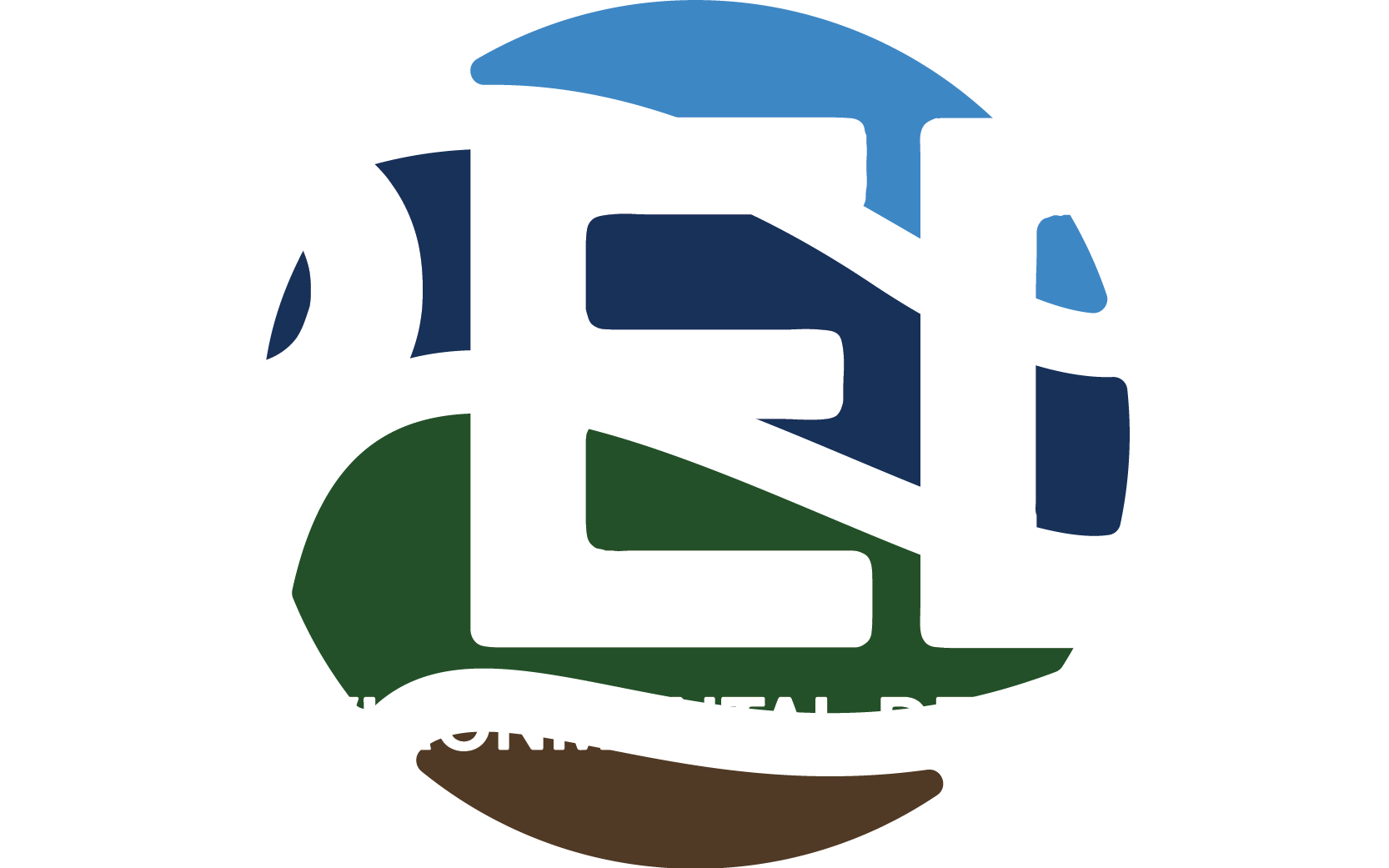Newsletter: Planet Pala Fall 2025

Planet Pala Newsletter
The Pala Environmental Department and Planet Pala announce the Planet Pala Fall 2025 Newsletter.
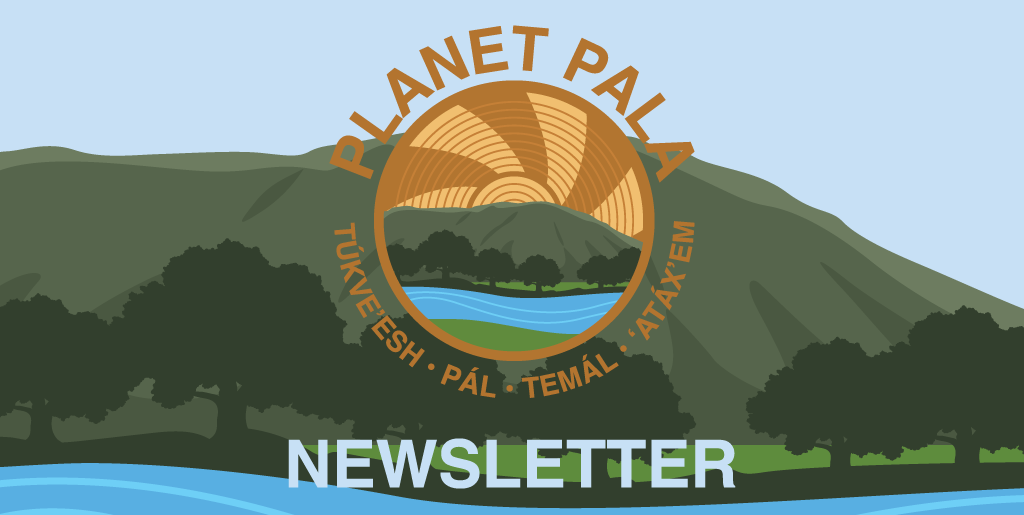
Letter from the Director
Welcome to News from Planet Pala.
Summer sure did go by fast! Now that fall is here, we can start looking forward to cooler weather and autumn holidays. Do you have a compost pile in your yard? PED hosted a waste audit in early September and discovered that lots of people are throwing away food waste that can be turned into compost. Keep reading to find out what else we found in the waste audit, and for all the information you need to start your own compost pile. Get inspired to start your own garden where you can use your compost, just like the Pala family. PED was able to help with our CNNCTS grant from SDSU! See photos of their new garden below.
Fall also brings us closer to the rainy season, which potentially means flooding. Keep your home and family safe with flood preparedness tips from the Pala Reservation Emergency Preparedness (PREP) project. And of course, cooler weather and longer nights make fall a great time to cuddle up with loved ones, just like the adorable bats featured in the More to Explore [SG1] section. Finally, we are thrilled to welcome Eyves Espiritu to the PED team. Read more about Eyves in her introductory article.
You can read all of our newsletters in the Planet Pala Newsletter archive.
Please contact us with comments, questions, or suggestions. We are here for Pala and you!

Flood Awareness & Preparedness
Forecasters are saying that La Niña conditions are likely to develop this fall for the second year in a row. What does that mean? Pala will experience drier, warmer weather. However, the Pala community faces the possibility of heavy rains and flooding. Seasonal storms can bring sudden and dangerous flooding, especially along the San Luis Rey River and creeks, which can quickly swell after heavy rain. The Tribe has experienced flooding in both the river and multiple creeks that are prone to flash flooding. Preparing ahead helps keep our families, elders, and community safe.
Know Pala’s Flood Risks
- The Pala Reservation is surrounded by riverbeds, creeks, and hillsides that can quickly channel rainwater during storms. Past events have shown how fast conditions can change, cutting off roads and threatening homes.
- Creeks like Pala Creek, Trujillo Creek, and Bubble-Up Creek carry stormwater from the mountains. Most flow only after storms, but Bubble-Up Creek runs year-round and has caused flooding.
- Past flood events have closed Pala Temecula Road, Pala Mission Road, Lilac Extension Road, and the Oaks neighborhood, where runoff from the hills can collect.
- More intense rain linked to climate change increases the likelihood of flash floods.
Flood Hot Spots
- Pala Temecula Road
- Pala Mission Road
- Lilac Extension Road
- Oaks Neighborhood (downhill runoff)
How To Prepare
Sign Up for Alerts
- Register with the Pala Emergency Alert System to receive emergency notifications.
Know Your Evacuation Routes
- Identify at least two ways out of your neighborhood. Some roads may become impassable during heavy rains.
- Practice with family members so everyone knows where to go.
Prepare a Disaster Supply Kit
- Include bottled water, flashlights, first aid supplies, blankets, and important documents in waterproof containers.
- Don’t forget medications and items for elders, children, and pets.
- Review the Pala Disaster Preparedness Handbook (.pdf) for a list of supplies needed.
Protect Your Home
- Clear debris from drains and gutters.
- Move valuables and important papers to higher ground.
- Use sandbags to redirect water away from doorways if needed.
Stronger Together
Preparedness is a community effort. By acting now—before the rains arrive—we can reduce risks, protect our families, and support one another. Flooding can be unpredictable, but when we prepare together – clearing drains, stocking supplies, and checking on our elders – we keep Pala stronger and safer.
The Pala PREP Team has resources to help you prepare for all types of emergencies. Visit the Pala PREP page for checklists, planning templates, and local updates.
Indigenous Peoples’ Day
Join us at the San Diego Zoo Safari Park for Indigenous Peoples’ Day on Monday, October 13, 2025.
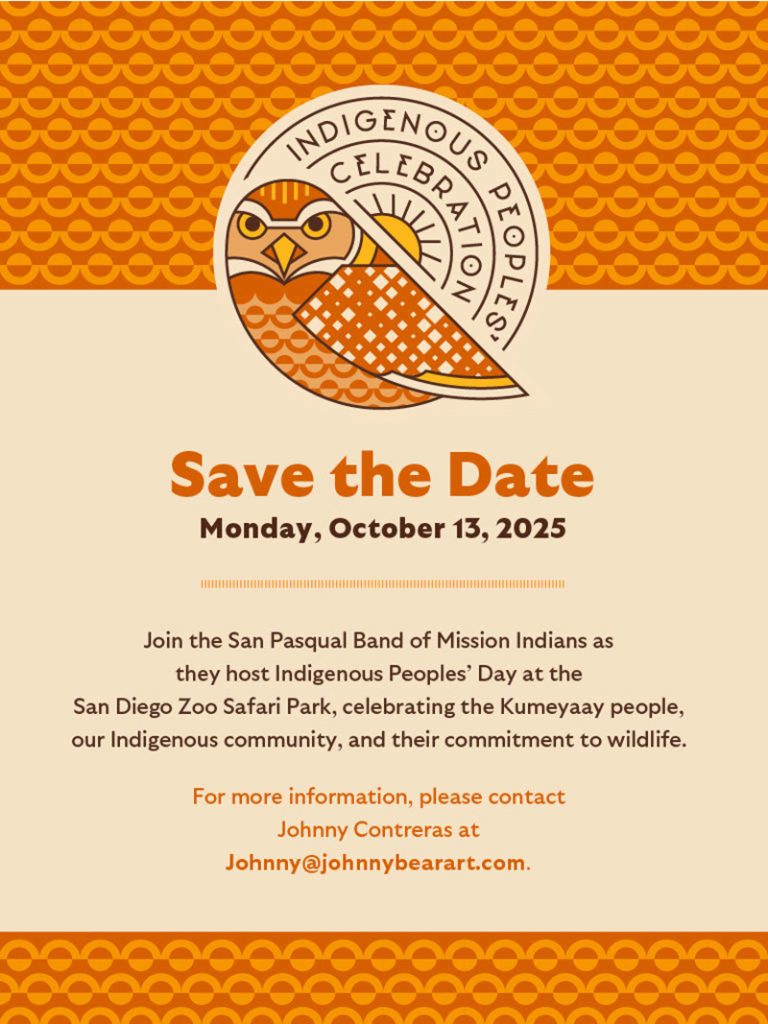

Composting 101
What Is Composting?
Composting is a natural process where organic materials are broken down enough that plants can then use those nutrients to help them grow. All organic matter decays over time, and home composting just tries to speed this process up a bit so that you can use it to feed your garden.
Compost:
- Improves the structure and fertility of garden soil
- Helps clay soil drain better; helps sandy soil hold more water
- Adds nutrients to the soil and is a good source of bacteria
- Helps to neutralize the pH levels in soil and prevent plant disease
How Do I Compost?
- Choose a type of compost container to use.
- Place food/kitchen and yard waste into the bin (chop it up small if you want it to compost faster). Try to add material in a roughly 50:50 mixture of greens (wet material): browns (dry material).
- When you first start your pile, add a handful of dirt, already finished compost, or a compost activator. They contain micro-organisms that help speed up the work of breaking organic matter down into compost.
- Adjust the moisture level. Your pile should be the consistency of a damp sponge, but not so wet that drops come out if you squeeze a handful of it. If it’s too wet, add some dry/brown material; too dry, sprinkle some water on your compost pile and turn it.
- Allow the pile to ‘bake;’ it should heat up quickly and reach the desired temperature (90°-140°F) in 4 to 5 days. This will kill weed seeds and any pathogens found in the material.
- Stir (or turn) your compost to speed up the decomposition (every 2-3 days; at least once/week).
- Your pile should shrink (settle) over time; this means it’s working.
- If you mix the pile once a week, it will become compost in 1-2 months; if you never mix the pile, your compost will be ready in 6-12 months.
- You’ll know it’s done when it looks dark and crumbly with small bits of organic material in it. It should have a sweet, earthy smell to it.
- Feed compost to your hungry plants, or amend your clay soil to improve your planting.
Why Should I Compost?

It’s easy! It only requires that you have some kind of container to hold your ingredients while they break down, and the ingredients themselves. The recipe is entirely up to you, so let’s get started.
Different Compost Systems
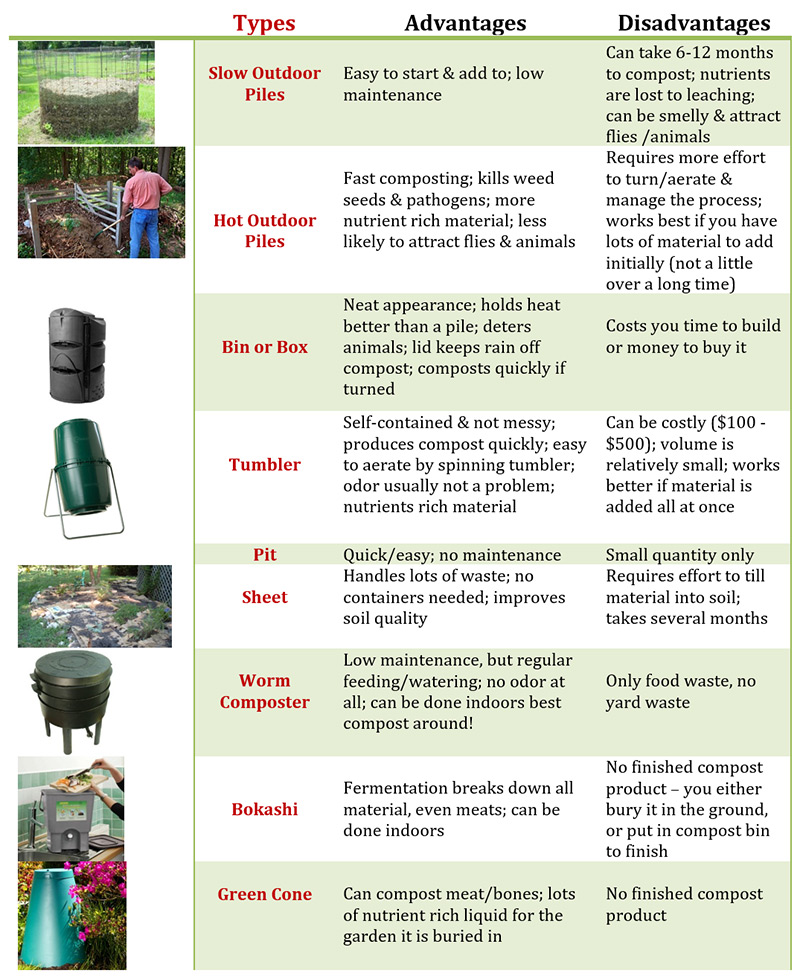
Troubleshooting Compost Issues
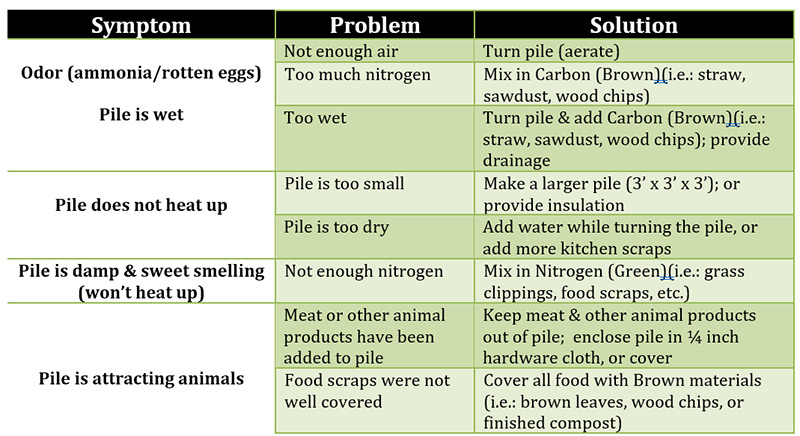
Preventing excessive odor requires consistent management of your compost pile, including attention to the ingredients that you add to your pile.
- Wet materials should be mixed with a coarse, dry bulking amendment (usually your browns like mulch & twigs) in order to increase porosity & allow more oxygen to get into the pile.
- Must be aerated (turned)
- It’s essential to understand the factors leading to anaerobic conditions: Interaction of particle size, porosity, moisture, and oxygen transport
Odor Problems:
- Usually, they are a result of low oxygen levels and/or anaerobic conditions
- Often start with incoming ingredients that are too wet or anaerobic
- Are a symptom of an important management factor that has been neglected or misunderstood
Most common factors that cause anaerobic odors:
- Excessive moisture
- Not enough porosity (holes) in pile
- Rapidly degrading substrate
- Excessive pile size
Best fix for anaerobic odors:
- More Oxygen!!! (turn pile, add coarse/dry brown material of different sizes)
Green vs. Brown Compost Material
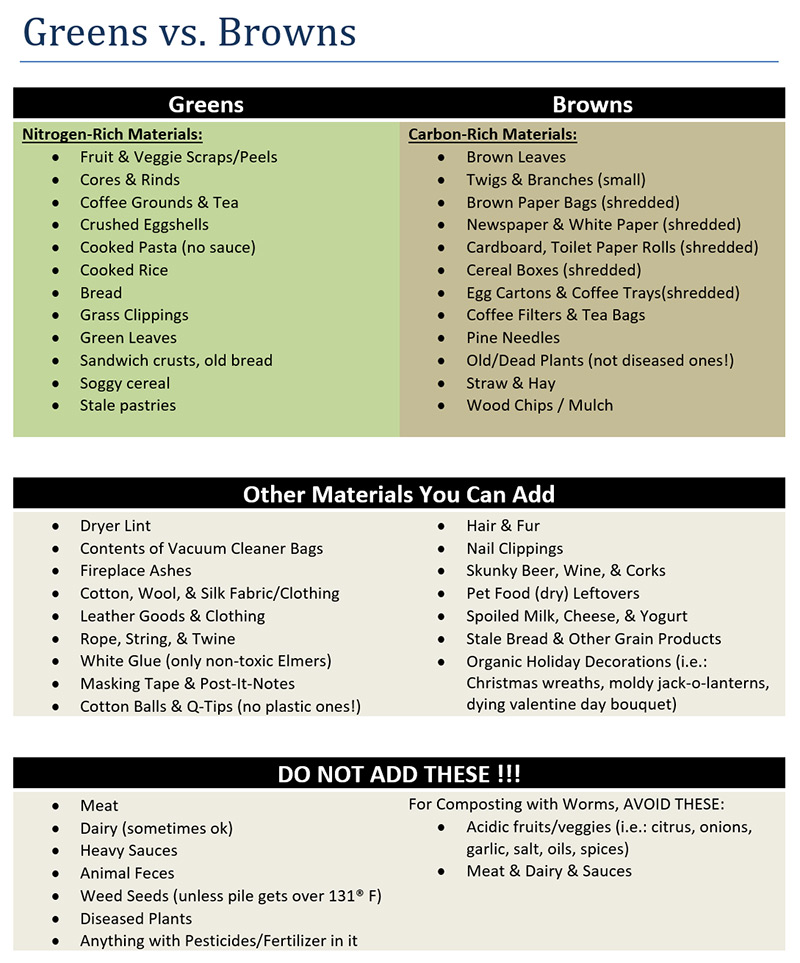

Cultivating Community: Garden Projects Growing with Grant Support
Pala was awarded $10,000 the second year in a row through a subagreement between the SDSU Research Foundation and the Pala Band of Mission Indians for the “Collaborative of Native Nations for Climate Transformation & Stewardship (CNNCTS)” project. The money was set to be allocated to 10 garden projects. Individuals applied for the opportunity to get $1,000 for a garden project last fall. We would like to share the success of one of those projects.
One of the standout success stories is the garden of John “Bud” Machado, Katey Shain, and their children. The $1,000 was used to buy raised beds, seeds, trellises, and hardware cloth to keep out wildlife. They also obtained organic mushroom soil on their own from a farm in Escondido. They put in a lot of work and have brought a new garden to life. How do they feel about their garden? Well, Katey stated, “We are so excited to have something off the ground away from creatures that is thriving!”
Pala’s Environmental Department is happy to be a part of a project that has empowered people to create garden spaces. We feel as though the garden is not just about growing plants; it’s about growing knowledge, working together, and deepening an appreciation for the land for years to come.
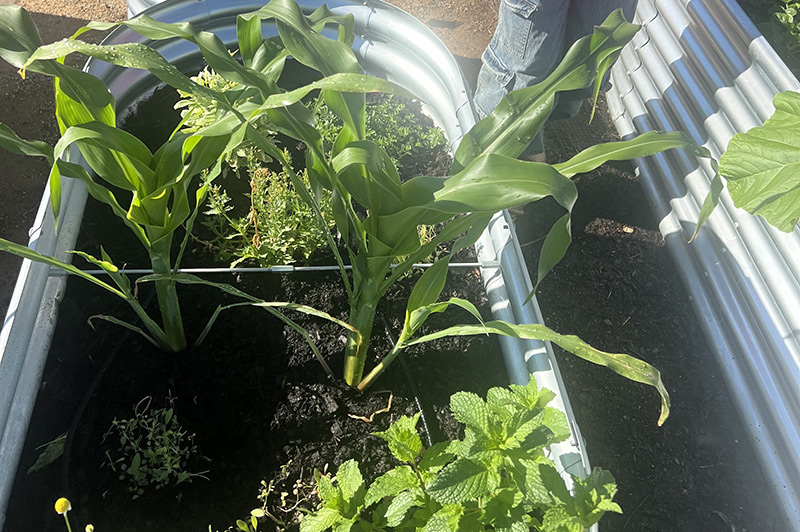
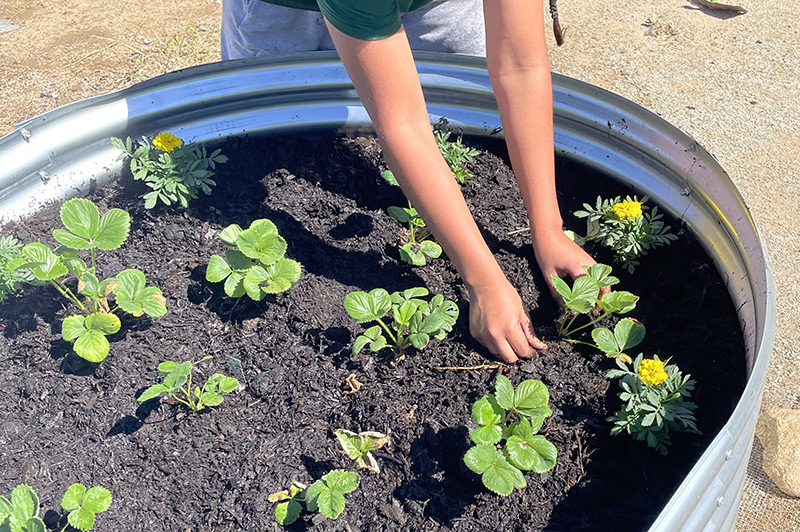

Researchers Found Bats that Cuddle
Researchers in Costa Rica used infrared cameras to observe a family of four spectral bats, which are known for being large and carnivorous, documenting behaviors such as hugging, huddling in tight “cuddle balls,” grooming, and sharing food. This study challenges the previous assumption that these bats are solitary and highlights their complex, cooperative social lives that help strengthen family bonds and ensure the survival of their offspring.
Read more, These giant carnivorous bats hug, cuddle — and even share dinner.
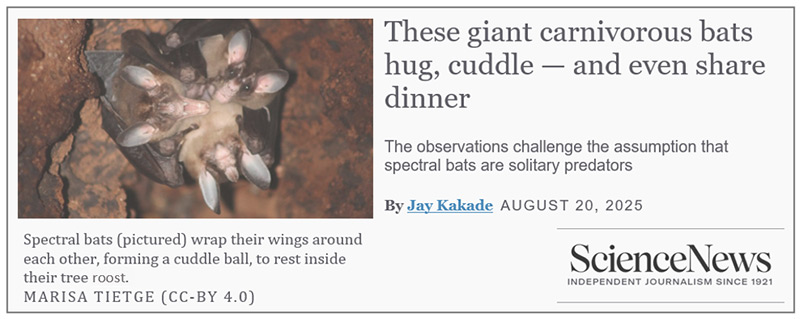

Waste Audit – 43% of Items in the Trash were NOT Trash
PED teamed up with the US EPA recently to hold a waste characterization study training with tribal environmental staff from California, Nevada, Arizona, and from the Commonwealth of the Northern Mariana Islands. A waste characterization study involves looking at what is being thrown away in the trash in a systematic way. This information helps to better inform our future programs and outreach. First, the trash is dumped out and sorted by hand, then all the materials are weighed and analyzed.
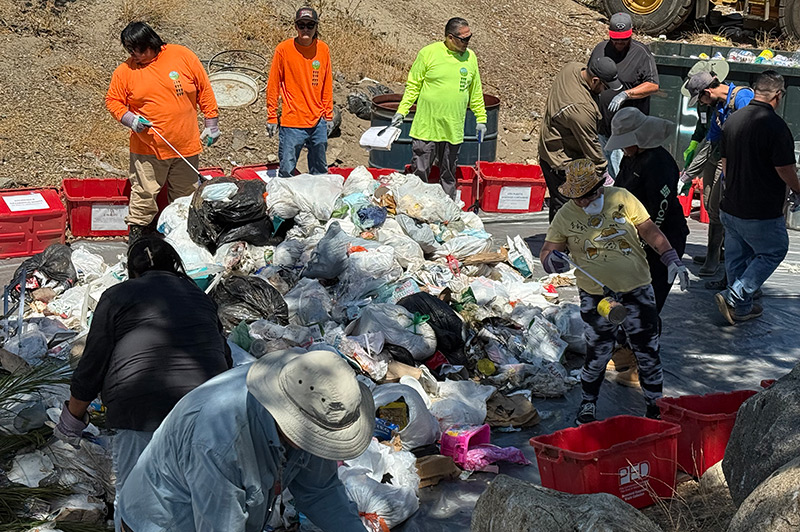
The categories we looked at were residual trash, CRV (CA redemption value materials), CRV with liquid, recyclable non-CRV, compostable, donatable clothes and shoes, and HHW. The only category that should be thrown in the trash is residual trash.

All of these clothes were in good enough condition to be donated.
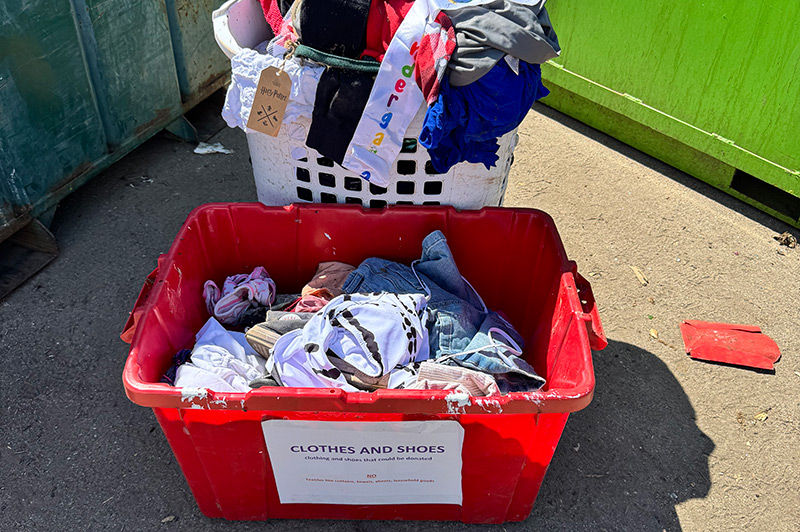
This is all recyclable materials that can be put in your blue recycling bin.
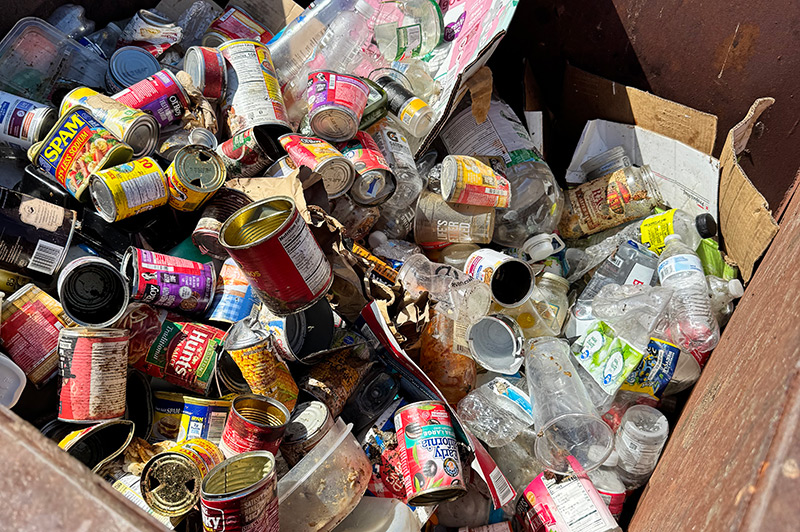
The Pala transfer station has ways to dispose of all other categories of waste. Visit the Pala Transfer Station page for more information.

Welcome to the Team

My name is Eyves Espiritu and I am grateful to be joining the Pala Environmental Department as a Grants Account Coordinator. I am thrilled to be part of this department with the opportunity to grow and learn new things.
A little intro about myself: I came here from the Philippines when I was only 9 years old and lived in Monterey Bay until I was 18. After I graduated high school, I went straight to college and attended SDSU in San Diego. I also attended National University in San Diego where I completed my course in Finance and received my bachelor’s degree. Currently, I’m married with two kids. My son is 12 years old and attending Warm Springs middle school as a 7th grader, and my daughter is 17 years old and attending Vista Murrieta High school as a senior.
For my past experiences, I have been in accounting and finance and have worked in different industries like Scripps Hospital, RV Industry, UPS finance department, and Cahuilla Casino etc. for over 20 years. Originally, I was supposed to be a nurse back in 2003 but decided to go a different route for many reasons because most Filipinos, like we all know, are mostly nurses or in the health industry.
For my leisure and hobbies, I enjoy singing, dancing, drawing, making jewelry, and other crafts that I find interesting. I’m currently singing with two bands (New Era and Tone 6) and enjoy meeting new people along the way, while entertaining the crowd. Most of our gigs are in Murrieta, Lake Elsinore, Rancho Cucamonga, and Cerritos.
When I’m not singing I spend my time with family going to theme parks, the mall, and places that my kids want to go to. Furthermore, I learned to cut hair as well when I was 20 years old when my boyfriend at the time, who is now my husband, was too lazy to go to the barber shop and spend money. So, I volunteered to cut his hair for the first time, which turned out ok for the first 30 minutes until he decided to move and by accident put a bald spot at the back! So, I had no choice but to go zero on the hair clipper attachment because of this and oh boy was he angry. To this day I still cut his hair even after that incident and my kids too trust me with theirs.
Lastly, I just want to say I’m happy to be given the opportunity to join the Pala Environmental Department. I look forward to more years working with all of you here and thank you from the bottom of my heart for this opportunity.

Planet Pala
Welcome to Planet Pala. This is the place to learn how you can help the Pala Environmental Department protect Mother Earth. Come to Planet Pala to learn about Pala’s plants and animals, discover how to do your fun activities like building a DIY bee habitat or planting a pollinator garden, and get tips on healthy, green living.
Planet Pala Newsletter Sign-up

Before You Go…
Did you receive this newsletter via email? Was it forwarded to you from a friend or family member? Help us spread the News from Planet Pala by making sure you are signed up on our subscription list and by sharing this newsletter. We are glad you are here!
Pala Environmental Department
For more information, contact the Pala Environment Department:
760-891-3510 | ped@palatribe.com | ped.palatribe.com
